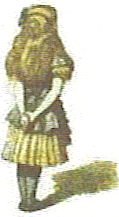A famous story about the boy wonder of mathematics has taken on a life of its own -Brian Hayes
Illustration by Theoni Pappas
In a fanciful drawing done in the manner of a woodcut, the young Carl Friedrich Gauss receives instruction in arithmetic from the schoolmaster J. G. Büttner. As the story goes, Gauss was about to give Büttner a lesson in mathematical creativity.
To me the historical significance of this research is important to me. People could chastise me for saying that the research I do has no quality, then what should be assumed with scientific credentials? Still the romance I have for such abstractions and development of thinking is important just the same. It is about creativity to me, and looking back to the ingenuity of thought, is something I can see in everyone. One doesn't have to consider them self less then, just by being the student that would solve the problem, while insight and acute perception, might have been revealed in one who could throw down the slate the quickest.
The story is fascinating tome on a lot of different levels and to tracking down the essence of what we see passed from one hand to another, and how this ambiguity might creep in and additions make there way for added material.
I understand this in our response to writing science, with what language is supposed to be. Sure talk about chinese , Italian, Latin of ole, and we want to know what the truest expression of the language should be?
Of course this is the responsibility of math, that a common basis be found, between all languages, that the source would have described it so abstract/yet closest to the center of the circle) that all would understand and could work the abstract nature of this math.
I feel guilty, that I cannot contribute so well to this math language, that I strive to listen very good to the concepts espoused, as close as possible to the development of this Algebraic way of seeing.
Yes, it is as important, as the geometrical seeing that it be inherent in the way things abstractly can be seen. That both would have supported the continued work fo science.
Mine then is the student's plight in a vast world that I exist away from, yet, try and stay as close as I can to learn.
Do I sanction everyones abilities away from this in character, is no less then the character I assume, and has been treated. That respect be given, might have found the truer calling of sharing the insights, be as truthful as possible. We should all strive to this of course.
What is Swirling in my Mind
As I lay there many things float through my mind about how we are seeing things now.
So the article above sparked some thoughts here about Sylvestor surfaces and B field understandings, that also included Lagrangian perspective along with WMAP polarization mapping. All these things seem so disconnected?
I keep finding myself trying to wrap all of this in a gravitational perspective as it should , no less important then gauss contributions, hidden for a time, while the student of his brings the perspective for us all to see. So how familiar is protege as Riemann that his Hypothesis is so much the like of the numbers apparent, as in the youthful gaze of the student challenged.

